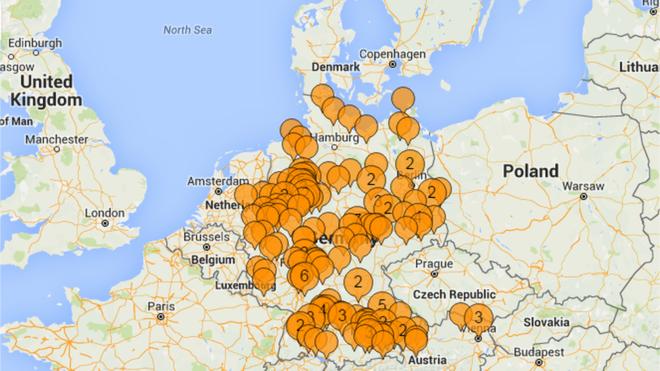 At some point in Europe’s refugee crisis, someone was going to say it. The unsayable, that is. “Lock up your bonny blonde, blue-eyed daughters, all you good burghers of Germany, Austria and other European countries. Lock them up carefully and well, for the Muslim hordes are coming.” Someone has now said it. Not those words exactly, but near enough.
At some point in Europe’s refugee crisis, someone was going to say it. The unsayable, that is. “Lock up your bonny blonde, blue-eyed daughters, all you good burghers of Germany, Austria and other European countries. Lock them up carefully and well, for the Muslim hordes are coming.” Someone has now said it. Not those words exactly, but near enough.
WSieci (the Network), a mass-market, politically conservative Polish magazine, featured an inflammatory cover showing a white woman wrapped in the European Union’s blue flag, her mouth open in a scream while three pairs of dark-skinned male hands pulled at her hair, clothes, waist and arms. The headline read: The Islamic Rape of Europe.
The message could not have been more unambiguous: Europe will be undone because Muslim refugees will take its women, claiming them sexually, forcing them to convert and bear their children, thereby increasing Muslim numbers on the continent. Or worse, that the refugees will prey on European women and assume dominance over their host societies by assault and humiliation.
What is that all about? The Polish magazine cover comes after unsavoury New Year’s Eve incidents in Cologne made headlines. Local women, who had gathered in the city centre to party, reported being groped and robbed by “gangs” of Arabs and North African men. There were allegations of rape. Similar complaints were subsequently lodged by women in other northern European cities.
It is hardly a coincidence that the complainants live in countries that are faced with the ceaseless influx of refugees. In times of stress, societies can be relied on to harken back to the deepest, most primeval fear known to man.
Put simply it is as follows: sexual assault can be a kind of self-annihilating shame for a people; it is the symbolic rape of the body of a whole community. As Danish academic Robin May Schott, who has written copiously on “war rape” says, it can be understood “not only as a tool for the unmaking of the social and cultural world but also a tool for the unmaking of the political world”.
Is this what Europeans really believe that harried Syrian refugees want? To unmake Europe? Cologne and other parallel incidents have provided far-right European Islamophobes, such as the Dutch politician Geert Wilders, with incendiary material to demonise refugees as “testosterone bombs… (bent on committing) sexual terrorism, a sexual jihad.” And now there is the wSieci magazine cover, which has turned a base canard into a community awareness exercise.
It would be funny if it weren’t so tragic. For the refugees, of course, hundreds of thousands of whom continue to make their wearied way to Europe, but it is tragic, too, for Europe that the undoubted political, social and cultural challenges of dealing with floods of refugees should have induced so great a fear of fulfilling its humanitarian duty.
Unfortunately, the Islamic Rape of Europe cover is hardly the only incidence of fear-mongering. A few weeks ago, Karolin Schwarz and Lutz Helm, who live in the eastern German town of Leipzig, created Hoaxmap to filter fiction from fact about refugees. Hoaxmap, which marks fake stories on a map of Europe, includes clickable links to full accounts about alleged incidents and how they are wrong.
The rumours follow a pattern, say the Hoaxmap creators. There are a lot of accusations of theft or rape. Sometimes, refugees are alleged to have urinated on the shelves of supermarkets, for example in Bautzen, a charge which Hoaxmap parried by linking to a German newspaper interview with the district police chief firmly denying it was true. “I have sent our people in every supermarket to ask,” Police Chief Conny Stiehl is quoted as saying. “Not a single case has been confirmed.”
So far, Hoaxmap claims it has 241 fake stories, mostly in Germany but also in Switzerland and Austria.
This is sterling work. However, it’s safe to say that, even if disproved, rumours of sexual assault — or cultural crossed signals — are likely to be believed. This is mostly because of the inherent fear of the barbarous “other”.

